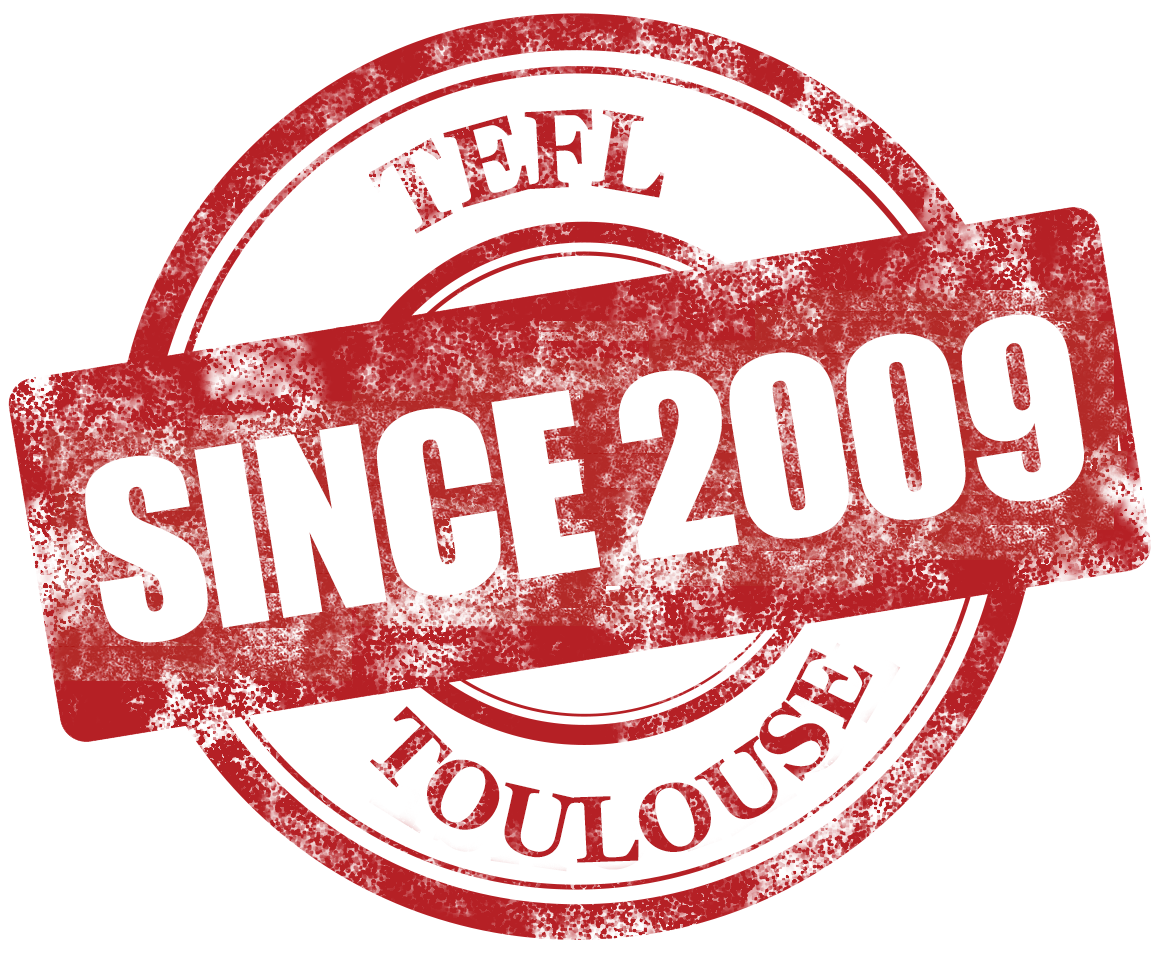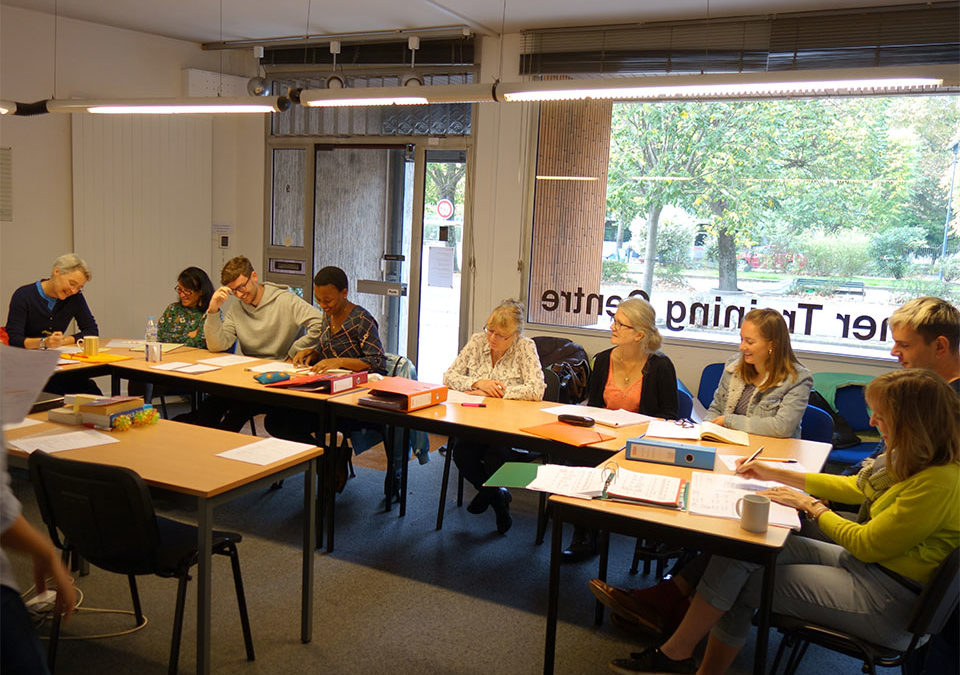First – a brief history of grammar teaching in TEFL
Teaching grammar – or teaching anything for that matter – used to be a question of the teacher just standing up and explaining it, hopefully using the whiteboard to add some rules that the students can copy down. Language teaching worldwide was done by translating from one’s own language.
The teacher wrote « hier j’ai mangé une salade » and explained that this was « yesterday I’ve eaten a salad ».
Nobody seemed to question the method – after all, that’s what teaching is, isn’t it ? The students should sit down and shut up so that everyone can hear and see the teacher, and concentrate.
But it became clear, nowhere more so than in France, that the students’ spoken English wasn’t improving.
One problem was that grammar can’t really be translated . « Hier j’ai mangé une salade » is actually « yesterday I ate a salad », not « have eaten ». And half the time «une salade » is a lettuce in French.
Noam Chomsky came into the picture at a critical moment too, claiming that children are already hard wired to learn grammar, and that we naturally form our own hypotheses (why children say “I eated it mummy”) about grammar rules. So perhaps teachers could relax about it all a bit. But the question remained….
How can we improve our grammar teaching in TEFL ? the profession asked
First of all it seemed clear that the students needed to be more involved, and get some speaking practice. The knee-jerk solution was to drill (ie « listen and repeat after me ») the rules and some example phrases. This was called « audio-lingualism ». Most French began to be able to say « Brian is in the kitchen » with fairly good pronunciation now, so things seemed to be looking up.
But the French still couldn’t actually say things they wanted to say, for example ask for directions, or compliment their friend on their new coat. Fast forward to grammar teaching in TEFL in 2022
Leaving the French “education nationale” aside for a moment, grammar teaching in TEFL has come a long way, although elements of these past approaches are still there.
Here are some improvements :
- Students now see real language in context, eg hearing or reading a dialogue between two real people – and are then encouraged to focus on any tendencies they can spot. For example they might begin to see that when we talk in the past, we tend to add « -ed » onto words. And that sometimes we don’t ! (eg ate, not eated). So we focus on tendencies after looking at real life examples. Real language examples become fundamental, rather than the creation of « Brian » type sentences to illustrate something already taught.
- The teacher now asks questions rather than just explains. For example « ok, are we talking about the past or the future here ? Is is a fixed plan or a prediction? » « what is the form of the verb? »
- Asking students questions rather than expaining things not only involves the students more, as they have to think and respond, but it also tells the teacher who understands and who doesn’t, and he or she can tailor their teaching accordingly. This « asking questions » is called « eliciting ».
- Drilling (listen and repeat) still takes place but natural pronunciation is encouraged. Students will be encouraged to say « I’ve met …. » rather than « I have met.. » and « going tuh » rather than « going to »
- Checking understanding is now an integral part of the process. The teacher shouldn’t give the students an excercise to do until he or she is fairly convinced that most have understood not only the rule, but also what they have to do*. A certain amount of thought needs to go into this, obviously « do you understand ? » doesn’t work as the students usually just say « yes » to please the teacher. More complex questions are required if the teacher really wants to find out if the students have understood. Eg « Can I use this to talk about daily routines ? » « Can someone give me an example sentence ? »
- The whiteboard (or something similar) is still used to show the « rules » . Several colours can make the board clearer and the whole thing a bit more enjoyable. Timelines , which are essentially a long line across the board showing « past, present and future » are used along with crosses, dotted lines and squiggles drawn on them to show when actions happen..
*students not doing the right thing is one of the most common classroom management problems and one that is often easily avoided. With higher levels you can ask questions to make sure they know what to do, eg « OK so is this speaking or a writing activity ? » « Do you do it alone or with your partner ? »
How to teach grammar then ? Here is one fail – proof method :
- Choose the grammar point you want to teach
- Either create or find a text – or audio – which contains multiple examples of the grammar point.
- Have the students read (in silence, not aloud) or listen to it first, and ask some general comprehension questions. Always focus on overall meaning of texts before starting to look at grammar rules.
- Then ask the students questions to draw their attention to a) the name of the tense, b) the function (ie the use) of the grammar point. A timeline drawn on the board will probably help you clarify things. And c) then draw their attention to the form (ie the structure). Write the tense name, the form and function on the board.
- Do some work with pronunciation to help them sound natural (I wuz waiting, not I wozz waiting)
- Check understanding of both the form and the function. This can be done by writing incorrect sentences on the board. Eg « Tomorrow I is going to London » (checks form) and « Last week Emma is going to Prague » (checks function)
- Once your teaching is over, give students a variety of activities to practice the grammar point. Some of these activities can be written, but some must be spoken. The students do these activities in pairs or 3s so that they can get some speaking practice and help each other. In any case it’s crucial that the students get time to practice what you have taught them. If the lesson is just « us teaching » then we are very much back to square one !
Has France begun to teach English grammar better ?
While French language schools and Universities are now full of TEFL qualified teachers, unfortunately school teaching of English still often resembles the very dated models mentioned at the top of this page.
Even simple concepts such as that of students taking to each other to get maximum speaking practice, are often absent. Lack of encouragement and even criticism of pupils when they get things wrong mean that the French grow up afraid to speak and afraid of making mistakes. Pupils are told to read Jane Eyre or Shakespeare at age 13, rather than graded reading books or magazines about their hobbies. They are also told that being accurate is more important than being fluent when speaking, despite the fact that native speakers make all sorts of mistakes in spoken English, and nobody seems to mind.
Speaking is the French classroom if often limited to getting a student to stand at the front of the class and recite a poem that they have been forced to learn by heart. It’s not uncommon for the child to begin or end this class in tears.
It does seem odd in 2022 that things haven’t changed especially when most French people will admit « on est nulle en Anglais »
Why doesn’t France change ?
Several reasons. One is that French people have historically tended to do French exams in English. Which in turn test knowledge of English, rather than speaking ability. In Southern Europe and South America for example, students have been doing Cambridge exams for years, and these test speaking ability to a great extent.
Protectionism is rife in France, and this includes protecting the French language. Until recently there were even laws preventing too many songs sung in English to be on the radio. So it’s hard to believe that English is very high on the “life skills” priorities list.
Another reason might be that the teachers themselves in secondary schools can’t really speak English. There are very few native-level English speaking teachers in the system. This is because, to become a teacher in France, one must undergo the long and arduous CAPES course. Many native speakers wouldn’t dare to try it, and many wouldn’t want to anyway, as you often get sent to the tough Parisian suburbs for your first job.
The good news is that TEFL teachers are slowly but surely being allowed into the national education system in France. TEFL teachers who can get themselves onto a list of supply teachers can often get in through the back door.
TEFL Teachers to the rescue !
Hopefully you can see now that established techniques for teaching and practicing grammar, found in the TEFL classroom need to spread into the national education system in France.
The essence is student participation, speaking time and asking questions rather than lecturing. TEFL Toulouse is looking forward to getting involved in the education nationale system, observing and providing feedback to existing language teachers.
Be part of that revolution with TEFL Toulouse !


